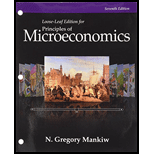
Subpart (a):
Wage rate.
Subpart (a):
Explanation of Solution
Daily wage can be derived as follows.
Wage is
Rearrange the wage equation in terms of labor
Labor demand is
Subpart (b):
Calculate wage rate, profit and income.
Subpart (b):
Explanation of Solution
Wage level with 200 labors can be calculated as follows.
Wage is 160.
Number of labor demanded by each firm can be calculated as follows.
Each firm employs 10 labors.
Profit can be calculated as follows.
Total profit for each firm is 200.
Total income can be calculated as follows.
Total income is $36,000.
Subpart (c):
Calculate wage rate and income.
Subpart (c):
Explanation of Solution
New daily wage can be derived as follows.
Wage is
Rearrange the wage equation in terms of labor
Labor demand is
Wage level with 200 labors can be calculated as follows.
Wage is 320.
Profit can be calculated as follows.
Total profit for each firm is 400.
Total income can be calculated as follows.
Total income is $36,000.
Subpart (d):
Calculate profit and income.
Subpart (d):
Explanation of Solution
Market demand function after the destruction can be derived as follows.
Labor demand is
Wage level with 200 labors can be calculated as follows.
Wage is 120.
Number of labor demanded by each firm can be calculated as follows.
Each firm employs 20 labors.
Profit can be calculated as follows.
Total profit for each firm is 800.
Total income can be calculated as follows.
Total income is $32,000. The total income decreased.
Want to see more full solutions like this?
Chapter 18 Solutions
Bundle: Principles of Microeconomics, 7th + LMS Integrated Aplia, 1 term Printed Access Card
- simple steps on how it should look like on excelarrow_forwardConsider options on a stock that does not pay dividends.The stock price is $100 per share, and the risk-free interest rate is 10%.Thestock moves randomly with u=1.25and d=1/u Use Excel to calculate the premium of a10-year call with a strike of $100.arrow_forwardCompute the Fourier sine and cosine transforms of f(x) = e.arrow_forward
- 17. Given that C=$700+0.8Y, I=$300, G=$600, what is Y if Y=C+I+G?arrow_forwardUse the Feynman technique throughout. Assume that you’re explaining the answer to someone who doesn’t know the topic at all. Write explanation in paragraphs and if you use currency use USD currency: 10. What is the mechanism or process that allows the expenditure multiplier to “work” in theKeynesian Cross Model? Explain and show both mathematically and graphically. What isthe underpinning assumption for the process to transpire?arrow_forwardUse the Feynman technique throughout. Assume that you’reexplaining the answer to someone who doesn’t know the topic at all. Write it all in paragraphs: 2. Give an overview of the equation of exchange (EoE) as used by Classical Theory. Now,carefully explain each variable in the EoE. What is meant by the “quantity theory of money”and how is it different from or the same as the equation of exchange?arrow_forward
- Zbsbwhjw8272:shbwhahwh Zbsbwhjw8272:shbwhahwh Zbsbwhjw8272:shbwhahwhZbsbwhjw8272:shbwhahwhZbsbwhjw8272:shbwhahwharrow_forwardUse the Feynman technique throughout. Assume that you’re explaining the answer to someone who doesn’t know the topic at all:arrow_forwardUse the Feynman technique throughout. Assume that you’reexplaining the answer to someone who doesn’t know the topic at all: 4. Draw a Keynesian AD curve in P – Y space and list the shift factors that will shift theKeynesian AD curve upward and to the right. Draw a separate Classical AD curve in P – Yspace and list the shift factors that will shift the Classical AD curve upward and to the right.arrow_forward
 Principles of Economics (MindTap Course List)EconomicsISBN:9781305585126Author:N. Gregory MankiwPublisher:Cengage Learning
Principles of Economics (MindTap Course List)EconomicsISBN:9781305585126Author:N. Gregory MankiwPublisher:Cengage Learning Principles of Economics, 7th Edition (MindTap Cou...EconomicsISBN:9781285165875Author:N. Gregory MankiwPublisher:Cengage Learning
Principles of Economics, 7th Edition (MindTap Cou...EconomicsISBN:9781285165875Author:N. Gregory MankiwPublisher:Cengage Learning Exploring EconomicsEconomicsISBN:9781544336329Author:Robert L. SextonPublisher:SAGE Publications, Inc
Exploring EconomicsEconomicsISBN:9781544336329Author:Robert L. SextonPublisher:SAGE Publications, Inc





